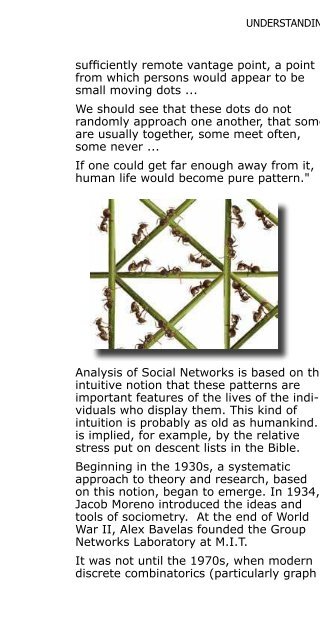Understanding the Millennial Mind: A Menace or ... - Big Business Zoo
Understanding the Millennial Mind: A Menace or ... - Big Business Zoo
Understanding the Millennial Mind: A Menace or ... - Big Business Zoo
You also want an ePaper? Increase the reach of your titles
YUMPU automatically turns print PDFs into web optimized ePapers that Google loves.
sufficiently remote vantage point, a point<br />
from which persons would appear to be<br />
small moving dots ...<br />
We should see that <strong>the</strong>se dots do not<br />
randomly approach one ano<strong>the</strong>r, that some<br />
are usually toge<strong>the</strong>r, some meet often,<br />
some never ...<br />
If one could get far enough away from it,<br />
human life would become pure pattern."<br />
Analysis of Social Netw<strong>or</strong>ks is based on <strong>the</strong><br />
intuitive notion that <strong>the</strong>se patterns are<br />
imp<strong>or</strong>tant features of <strong>the</strong> lives of <strong>the</strong> individuals<br />
who display <strong>the</strong>m. This kind of<br />
intuition is probably as old as humankind. It<br />
is implied, f<strong>or</strong> example, by <strong>the</strong> relative<br />
stress put on descent lists in <strong>the</strong> Bible.<br />
Beginning in <strong>the</strong> 1930s, a systematic<br />
approach to <strong>the</strong><strong>or</strong>y and research, based<br />
on this notion, began to emerge. In 1934,<br />
Jacob M<strong>or</strong>eno introduced <strong>the</strong> ideas and<br />
tools of sociometry. At <strong>the</strong> end of W<strong>or</strong>ld<br />
War II, Alex Bavelas founded <strong>the</strong> Group<br />
Netw<strong>or</strong>ks Lab<strong>or</strong>at<strong>or</strong>y at M.I.T.<br />
It was not until <strong>the</strong> 1970s, when modern<br />
discrete combinat<strong>or</strong>ics (particularly graph<br />
UNDERSTANDING THE MILLENNIAL MIND: A MENACE OR AMAZING? | 9<br />
<strong>the</strong><strong>or</strong>y) experienced rapid development<br />
and relatively powerful computers became<br />
readily available, that <strong>the</strong> study of Social<br />
Netw<strong>or</strong>ks really became recognized as an<br />
interdisciplinary specialty.<br />
Since <strong>the</strong>n its growth has been rapid. Today<br />
it has become an inter-national eff<strong>or</strong>t with<br />
its own professional <strong>or</strong>ganizations, textbooks,<br />
journals, research centers, training<br />
centers and computer programs designed<br />
specifically to facilitate <strong>the</strong> analysis of structural<br />
data.<br />
Root Cause Analysis<br />
Let’s go back to <strong>the</strong> ma<strong>the</strong>matics of <strong>the</strong><br />
call center situation. I had to find <strong>the</strong><br />
significant variables. What really changed?<br />
What is different? Everyone knows that<br />
every generation has a falling out with<br />
<strong>the</strong>ir parents. If it is not loud music, it<br />
is Mohawks, tattoos, drugs, etc. Every<br />
generation has had this schism with <strong>the</strong>ir<br />
parents. I ask groups: “How many of you<br />
did not have a breaking issue with your<br />
parents?” and maybe one person raises<br />
<strong>the</strong>ir hand (I’m sure <strong>the</strong>y are <strong>the</strong> <strong>or</strong>phans).<br />
So, this always happens. Except, what<br />
we are talking about is NOT that! This is<br />
not <strong>the</strong> same-old, same-old routine that<br />
happens with every generation. This is<br />
really very different on a lot of levels and in<br />
a lot of ways.<br />
Mostly <strong>the</strong> people that have been researching<br />
this issue have been looking at “How<br />
are <strong>the</strong>y different?” That is not a bad thing<br />
to look at, but “Why?” is even better. The<br />
most imp<strong>or</strong>tant question to start with is<br />
“When?” When did it become different?<br />
What is <strong>the</strong> far<strong>the</strong>st back we can look?


